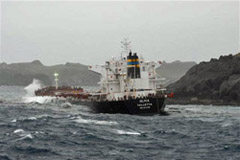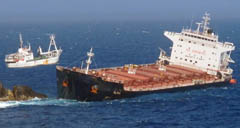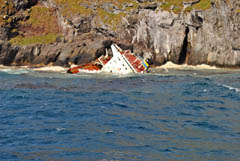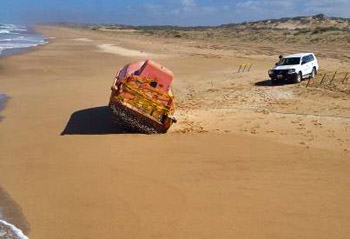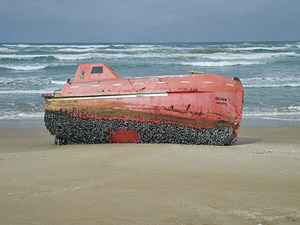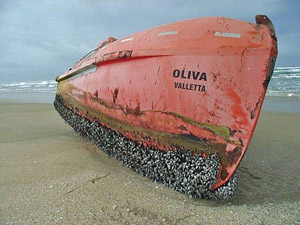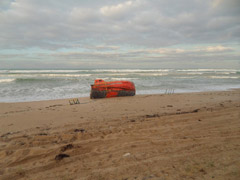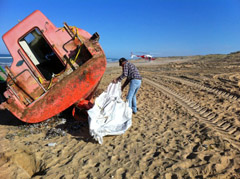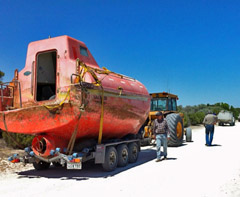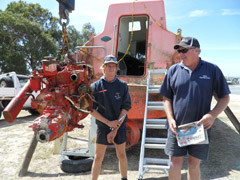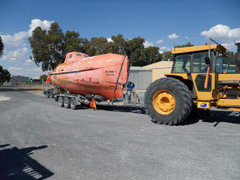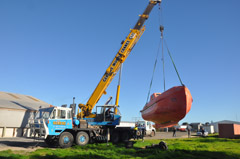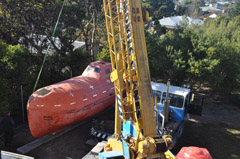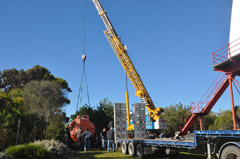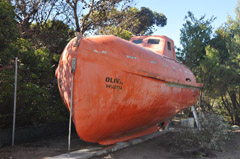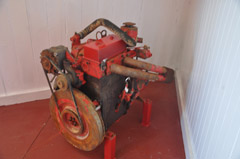MS Oliva Lifeboat found 99 weeks after being lost
MS Oliva Lifeboat found 99 weeks after being lost |
||
|
|
|
Images of MS Oliva after running aground at Spinners Point on Nightingale Island
on 16th March 2011 |
||
Press Release from the Government of South Australia's The life raft beached near Salt Creek on the Coorong earlier this month after coming adrift when the carrier ran aground off Nightingale Island, Tristan Da Cunha, in March 2011. DPTI Manager Marine Services Joe Rositano said the environmentally sensitive and isolated location of the life raft within the Coorong National Park means recovering the 7 metre long vessel is no easy task. 'There are only two options for removal at this location, either by sea, or by mounting it and driving approximately 30kms along the beach to Tea Tree Crossing,' he said. 'We understand the insurers have authorised local contractors to remove the vessel and, pending approval from the Environment Protection Authority (EPA), the second option is most likely'. The life raft will be inspected by officers from Biosecurity SA tomorrow ahead of its removal. 'The insurers have indicated they are comfortable with the life raft remaining in the South East. That is a matter for the insurers and they are dealing directly with parties who have expressed their interest,' Mr Rositano said. We thank DPTI Media manager Sam Rodrigues for keeping us up to date. |
Oliva Lifeboat |
Marine Safety Officers from the Department of Planning, Transport and Infrastructure will travel to Salt Creek this week to check on the Oliva life raft following strong winds over the weekend to ensure it remains securely beached. DPTI has made contact with the insurers who have indicated they will recover the life raft. Given the isolated location of the life raft, it is expected this will take time. Photo Courtesy of Australian Channel 7 Sam Rodrigues
represents the |
|
Oliva Lifeboat |
Sam Rodrigues from the Department of Planning, Transport and Infrastructure (DPTI) in Adelaide, South Australia has contacted us and sent this image of what she describes as the MS Oliva life raft on the beach near Salt Creek South Australia taken on 7th February. Sam reported that the DPTI was awaiting contact with the Oliva’s owners / insurers before proceeding with any action. Sam intends to send further images and reports of the salvage operation over the next few days so watch this space! We are again grateful for liaison assistance from Steve Reardon from Adelaide who has been in touch with the DPTI in respect of keeping us in touch with further developments as we continue to chronicle the ‘Oliva Wreck Saga’ as it enters a new and unexpected episode. |
 |
MS Oliva Lifeboat washed up in Australia |
||
|
|
|
Images of MS Oliva's Lifeboat with thanks to ABC News Australia |
||
ABC News in Australia reported on 6th February 2013 that the lifeboat from the wrecked bulk carrier MS Oliva was washed up on a beach in South Australia. The lifeboat was found by Nick Balmer when he went fishing and reported that it was in good condition after its long journey. "The seats inside are torn up so, you know, the chances are it's probably been sitting on other beaches around the world maybe, you know, and people have sort of trashed it inside a bit," he said. "The lifejacket was out on the beach down the Coorong there so we're not the first person to find it." The South Australian Transport Department were at first unsure what to do with the 6.8-metre lifeboat. Official Joe Rositano said departmental staff were travelling to the beach near Salt Creek and planned to ensure the boat could not wash back out to sea. "What we're going to make sure is that it actually doesn't become a navigation hazard again," he said. "What we're going to look at doing is perhaps anchoring it initially because the thing weighs, without the water in it it's a couple of tonnes, so it's not an easy thing to move." Text and images from the ABC Website : http://www.abc.net.au/news/ We will aim to keep this news page updated |
||
| How the Oliva Lifeboat was lost Website visitors can search other Oliva pages (see links below) which chronicle the MS Oliva wreck and its aftermath in detail. It was not until the Maltese Government's Marine Safety Report was published that the details of what happened to the lifeboat (now discovered on a beach in South Australia) were known. The following is an extract from the article on the safety report in the February 2013 Tristan da Cunha Newsletter: .... at first light (on 16th March 2011) the master instructed the crew to don life jackets, and launch their lifeboat. This was done and the lifeboat secured alongside. In the event 12 crew members were transferred to MV Edinburgh by the fishing vessel’s boat. How did it get there? Many theories but no facts! Others may argue that, like the Wandering Albatrosses, the lifeboat may have tracked further south, and continued beyond the south of New Zealand, into the Pacific, following an almost continuous easterly drift of ocean currents around the Southern Ocean, eventually passing Cape Horn, back into the Atlantic, passing South of the Cape of Good Hope again...and hence to South Australia. Any other ideas? Those really interested should start by linking to the ABC website above and hear the interview with the man who found it : |
If you are new to the MS Oliva Wreck story you may want to read more about the full story by following links at th bottom of this page ~ here we highlight some of the main points to whet your appetite Through incompetence the 75,300 tonne bulk carrier MS Oliva ran aground early on 16th March 2011 The crew were rescued following help from the crews of MV Edinburgh and MV Prince Albert II on 16th and 17th March Captain Clarence October of MV Edinburgh was awarded an honorary MBE by HM Queen Elizabeth II following this incident MS Oliva broke up during the night of 17th / 18th March and some 1500 tonnes of fuel oil and 65,000 tonnes of soya beans leaked out Oil slicks washed ashore on Nightingale and Inaccessible Islands threatening wildlife 3718 oiled Rockhopper Penguins were transferred to Tristan da Cunha for rehabilitation ~ unfortunately only 10% survived The RSPB presented the community of Tristan da Cunha with their prestigious Medal in 2012 for this conservation work Nightingale and Inaccessible fishing grounds were closed but have re-opened by 2013 A full and final insurance settlement was announced in September 2012 The Maltese Government Transport Department issued a Marine Safety Report in November 2012 explaining the causes of the wreck The missing lifeboat was discovered in South Australia in February 2013 The August 2013 Tristan da Cunha Newsletter will carry a feature on Nightingale Island evaluating the effects of the wreck on wildlife two years after the disaster |
See also: A diary of the first phase of the disaster up to Monday 21st March : Oliva Wreck 1 A catalogue of the clean-up operation on Nightingale and Inaccessible after 21st March: Oliva Phase II News A page providing news and pictures of the back-up operation on the main Tristan da Cunha Island : Oliva Tristan Diary Impact of MS Oliva Disaster on Tristan's Fishing Industry: Oliva Fishing News A page providing a Tristan Government view of the Oliva disaster as it unfolds: Oliva Government News Report explaining the cause of the grounding and safety lessons learned: MS Oliva Safety Report MS Oliva Disaster Home Page and Links |

